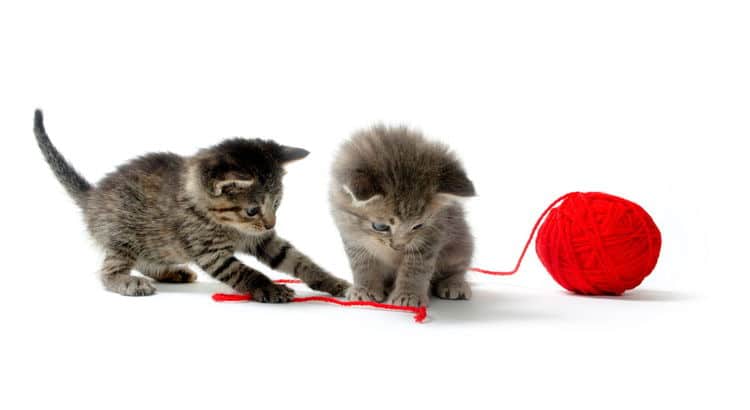
* Pin Paws Pet Care is powered by MetLife effective 2021 with new plan options.
Cats are mischievous little critters at risk for accidents and as all animals, are susceptible to developing illnesses. In researching cat health, here is a list of the top 10 most common conditions for the feline population:
- Stomach issues
- Urinary tract infections
- Skin conditions
- Cancer
- Eye conditions
- Ear infections
- Pain
- Growth
- Foreign body obstruction
- Allergies
If you have ever owned a cat or been around one, you have probably witnessed the hacking up of a hairball. This is something we don’t desire to witness, however, it’s just a fact about cats. Stomach issues affect a cats health and can be caused by many things including pancreatitis, bacterial infections, constipation or abdominal obstruction. Diagnosing the cause of stomach issues can include x-ray, CT scans, lab testing (including FIV and Leukemia testing) and endoscopy. You can improve cat health by kitty-proofing your house, removing poisonous plants, yarn/string, and antifreeze.
Urinary tract infections can be the results of kidney infections, bladder stones or urinary crystals and are most commonly found in cats between the ages of one and four. Symptoms of a urinary tract infection include frequent urination, urinating in odd places other than their litter box, vomiting, blood in the urine, lethargy and excessive thirst to name a few. Treatment to improve a cats health can include antibiotics, laser therapy and possibly surgery.
Cats are notorious for bathing and grooming themselves. However excessive behaviors of the like can cause poor skin conditions. Cats who spend time outdoors are also prone to developing skin conditions as they are exposed to parasites and can also develop an abscess from a catfight. It is fairly easy to identify a skin condition as it is visible to the naked eye. Look for scratching, dry or flaky skin, cuts or wounds, or redness. Treatment can vary from antibiotics, parasitic or thyroid treatment, medical baths, antifungal treatments, and topical medications. If a cat develops skin cancer they may be required to undergo surgery for removal.
Feline Leukemia Virus (FeLV) is a cancer commonly affecting cats. Squamous Cell Carcinoma (a form of skin cancer) and Fibrosarcoma (soft tissue sarcoma) are also types of feline cancer and all are associated with lymphoma. Signs and symptoms your cat may have cancer include abnormal swelling or lumps, sores that do not heal, change in eating habits, difficulty breathing or using the bathroom, bleeding, a strange odor or altogether a change in behavior. Treatment can vary from surgery to chemotherapy followed by ongoing care of alternative treatments and prescription medications.
Cats are curious creatures maneuvering about and commonly getting into accidents. With this known fact, it is important to keep a good look on their eye health. Signs of an eye condition include squinting, unhealthy discharge, blindness, redness, pawing at the eye or face, dry eye or decreased appetite. Medication or surgery can be used to resolve eye conditions ranging from Atropine Sulfate Ophthalmic solution (painkiller drops) to Enucleation (eye removal).
Ear infections are more common in cats with diabetes or a weakened immune system, however, all cats inclusively are susceptible to getting an ear infection. Scratching, discharge, odor, redness and swelling, hearing loss, walking in circles and shaking of the head are signs your cat may have an ear infection. Treatments can include flushing out the infection, antibiotics, antifungal treatments, BNT treatment, pain medication or surgery. To prevent an ear infection, routinely check to make sure there is no redness, residue, visible wax or odor.
As pet parents, one of the things we dread the most is if our fur kitty is in pain. Signs and symptoms they may be hurting include limping, crying or yowling, lethargic behavior, appetite changes, grimacing, panting or drooling or excessive grooming. Adequan injections may be warranted for arthritic cats, as well as laser therapy or acupuncture. Chiropractic care can be used to improve a cat’s relationship between their spine and nervous system. Hydrotherapy is also an option, however, I cannot imagine any cat that would enjoy being in the water. A good rule of thumb is if your cat looks like it is in pain, take them to the vet.
If you detect a growth or lump on your cat, get them to the vet. This can be anything from a fat pad to a cyst or a benign tumor. Some signs that might represent a growth on your cat include a lump or bump, swelling, weight loss, anorexia, strange odors, difficulty breathing or problems going to the bathroom. Treatment can include cyst drainage, laser surgery, or chemotherapy and radiation. Vets recommend keeping your cat indoors to avoid any outdoor trauma and to feed them a healthy diet of wet food and plenty of water daily.
Cats are commonly known to get into any and everything. This can lead to them ingesting something they should not have and ultimately a foreign body obstruction. Unfortunately, we do not have x-ray vision to see the yarn, rubber bands, toilet paper, and even rodents and insects lodged in their GI tract. If your cat ingests something, it takes 10-24 hours for it to move through their digestive tract. This is when we hope the cat will induce vomiting as mentioned earlier with the hairball. In the event they begin showing signs of having a bowel obstruction, get them to the vet promptly. Signs could include vomiting, diarrhea, lack of appetite, lethargy or abdominal pain/hissing when you try to pick them up. X-rays along with blood and urine tests will be performed to determine the location of the object and overall health of the pet. Endoscopy can be used to remove the object by inserting a tube in their mouth to their stomach and pulling the object out. If the object has made it to the stomach, surgery will be performed.
Allergies affect cats just as they do humans. Cats can suffer from being allergic to grass, trees, and pollen in addition to having food allergies. Many cats are also allergic to fleas, however, do not use canine flea control on a cat as it can make them very sick. Cats with food allergies may develop itchy skin or have recurrent ear infections. Treatments for allergies include creams, flea treatment, antihistamine medication, allergy shots, and other medications.
As we can see, cats are prone to accidents and illnesses. It is estimated that 1 in 3 pets will need urgent vet care this year and every 6 seconds an owner is given a vet bill of more than $1,000. Pet insurance is a sure way to protect your pocketbook should any of the above situations happen to your cat. With a Pin Paws Plus membership, you will have access to whiskerDocs, pet telehealth. This service provides pet owners access to a vet 24/7 via text, chat, call or video to determine if a pet needs simple home observation or emergency care.
Table of content
Related articles

* Pin Paws Pet Care is powered by MetLife effective 2021 with new plan options.
Cats are mischievous little critters at risk for accidents and as all animals, are susceptible to developing illnesses. In researching cat health, here is a list of the top 10 most common conditions for the feline population:
- Stomach issues
- Urinary tract infections
- Skin conditions
- Cancer
- Eye conditions
- Ear infections
- Pain
- Growth
- Foreign body obstruction
- Allergies
If you have ever owned a cat or been around one, you have probably witnessed the hacking up of a hairball. This is something we don’t desire to witness, however, it’s just a fact about cats. Stomach issues affect a cats health and can be caused by many things including pancreatitis, bacterial infections, constipation or abdominal obstruction. Diagnosing the cause of stomach issues can include x-ray, CT scans, lab testing (including FIV and Leukemia testing) and endoscopy. You can improve cat health by kitty-proofing your house, removing poisonous plants, yarn/string, and antifreeze.
Urinary tract infections can be the results of kidney infections, bladder stones or urinary crystals and are most commonly found in cats between the ages of one and four. Symptoms of a urinary tract infection include frequent urination, urinating in odd places other than their litter box, vomiting, blood in the urine, lethargy and excessive thirst to name a few. Treatment to improve a cats health can include antibiotics, laser therapy and possibly surgery.
Cats are notorious for bathing and grooming themselves. However excessive behaviors of the like can cause poor skin conditions. Cats who spend time outdoors are also prone to developing skin conditions as they are exposed to parasites and can also develop an abscess from a catfight. It is fairly easy to identify a skin condition as it is visible to the naked eye. Look for scratching, dry or flaky skin, cuts or wounds, or redness. Treatment can vary from antibiotics, parasitic or thyroid treatment, medical baths, antifungal treatments, and topical medications. If a cat develops skin cancer they may be required to undergo surgery for removal.
Feline Leukemia Virus (FeLV) is a cancer commonly affecting cats. Squamous Cell Carcinoma (a form of skin cancer) and Fibrosarcoma (soft tissue sarcoma) are also types of feline cancer and all are associated with lymphoma. Signs and symptoms your cat may have cancer include abnormal swelling or lumps, sores that do not heal, change in eating habits, difficulty breathing or using the bathroom, bleeding, a strange odor or altogether a change in behavior. Treatment can vary from surgery to chemotherapy followed by ongoing care of alternative treatments and prescription medications.
Cats are curious creatures maneuvering about and commonly getting into accidents. With this known fact, it is important to keep a good look on their eye health. Signs of an eye condition include squinting, unhealthy discharge, blindness, redness, pawing at the eye or face, dry eye or decreased appetite. Medication or surgery can be used to resolve eye conditions ranging from Atropine Sulfate Ophthalmic solution (painkiller drops) to Enucleation (eye removal).
Ear infections are more common in cats with diabetes or a weakened immune system, however, all cats inclusively are susceptible to getting an ear infection. Scratching, discharge, odor, redness and swelling, hearing loss, walking in circles and shaking of the head are signs your cat may have an ear infection. Treatments can include flushing out the infection, antibiotics, antifungal treatments, BNT treatment, pain medication or surgery. To prevent an ear infection, routinely check to make sure there is no redness, residue, visible wax or odor.
As pet parents, one of the things we dread the most is if our fur kitty is in pain. Signs and symptoms they may be hurting include limping, crying or yowling, lethargic behavior, appetite changes, grimacing, panting or drooling or excessive grooming. Adequan injections may be warranted for arthritic cats, as well as laser therapy or acupuncture. Chiropractic care can be used to improve a cat’s relationship between their spine and nervous system. Hydrotherapy is also an option, however, I cannot imagine any cat that would enjoy being in the water. A good rule of thumb is if your cat looks like it is in pain, take them to the vet.
If you detect a growth or lump on your cat, get them to the vet. This can be anything from a fat pad to a cyst or a benign tumor. Some signs that might represent a growth on your cat include a lump or bump, swelling, weight loss, anorexia, strange odors, difficulty breathing or problems going to the bathroom. Treatment can include cyst drainage, laser surgery, or chemotherapy and radiation. Vets recommend keeping your cat indoors to avoid any outdoor trauma and to feed them a healthy diet of wet food and plenty of water daily.
Cats are commonly known to get into any and everything. This can lead to them ingesting something they should not have and ultimately a foreign body obstruction. Unfortunately, we do not have x-ray vision to see the yarn, rubber bands, toilet paper, and even rodents and insects lodged in their GI tract. If your cat ingests something, it takes 10-24 hours for it to move through their digestive tract. This is when we hope the cat will induce vomiting as mentioned earlier with the hairball. In the event they begin showing signs of having a bowel obstruction, get them to the vet promptly. Signs could include vomiting, diarrhea, lack of appetite, lethargy or abdominal pain/hissing when you try to pick them up. X-rays along with blood and urine tests will be performed to determine the location of the object and overall health of the pet. Endoscopy can be used to remove the object by inserting a tube in their mouth to their stomach and pulling the object out. If the object has made it to the stomach, surgery will be performed.
Allergies affect cats just as they do humans. Cats can suffer from being allergic to grass, trees, and pollen in addition to having food allergies. Many cats are also allergic to fleas, however, do not use canine flea control on a cat as it can make them very sick. Cats with food allergies may develop itchy skin or have recurrent ear infections. Treatments for allergies include creams, flea treatment, antihistamine medication, allergy shots, and other medications.
As we can see, cats are prone to accidents and illnesses. It is estimated that 1 in 3 pets will need urgent vet care this year and every 6 seconds an owner is given a vet bill of more than $1,000. Pet insurance is a sure way to protect your pocketbook should any of the above situations happen to your cat. With a Pin Paws Plus membership, you will have access to whiskerDocs, pet telehealth. This service provides pet owners access to a vet 24/7 via text, chat, call or video to determine if a pet needs simple home observation or emergency care.

* Pin Paws Pet Care is powered by MetLife effective 2021 with new plan options.
Cats are mischievous little critters at risk for accidents and as all animals, are susceptible to developing illnesses. In researching cat health, here is a list of the top 10 most common conditions for the feline population:
- Stomach issues
- Urinary tract infections
- Skin conditions
- Cancer
- Eye conditions
- Ear infections
- Pain
- Growth
- Foreign body obstruction
- Allergies
If you have ever owned a cat or been around one, you have probably witnessed the hacking up of a hairball. This is something we don’t desire to witness, however, it’s just a fact about cats. Stomach issues affect a cats health and can be caused by many things including pancreatitis, bacterial infections, constipation or abdominal obstruction. Diagnosing the cause of stomach issues can include x-ray, CT scans, lab testing (including FIV and Leukemia testing) and endoscopy. You can improve cat health by kitty-proofing your house, removing poisonous plants, yarn/string, and antifreeze.
Urinary tract infections can be the results of kidney infections, bladder stones or urinary crystals and are most commonly found in cats between the ages of one and four. Symptoms of a urinary tract infection include frequent urination, urinating in odd places other than their litter box, vomiting, blood in the urine, lethargy and excessive thirst to name a few. Treatment to improve a cats health can include antibiotics, laser therapy and possibly surgery.
Cats are notorious for bathing and grooming themselves. However excessive behaviors of the like can cause poor skin conditions. Cats who spend time outdoors are also prone to developing skin conditions as they are exposed to parasites and can also develop an abscess from a catfight. It is fairly easy to identify a skin condition as it is visible to the naked eye. Look for scratching, dry or flaky skin, cuts or wounds, or redness. Treatment can vary from antibiotics, parasitic or thyroid treatment, medical baths, antifungal treatments, and topical medications. If a cat develops skin cancer they may be required to undergo surgery for removal.
Feline Leukemia Virus (FeLV) is a cancer commonly affecting cats. Squamous Cell Carcinoma (a form of skin cancer) and Fibrosarcoma (soft tissue sarcoma) are also types of feline cancer and all are associated with lymphoma. Signs and symptoms your cat may have cancer include abnormal swelling or lumps, sores that do not heal, change in eating habits, difficulty breathing or using the bathroom, bleeding, a strange odor or altogether a change in behavior. Treatment can vary from surgery to chemotherapy followed by ongoing care of alternative treatments and prescription medications.
Cats are curious creatures maneuvering about and commonly getting into accidents. With this known fact, it is important to keep a good look on their eye health. Signs of an eye condition include squinting, unhealthy discharge, blindness, redness, pawing at the eye or face, dry eye or decreased appetite. Medication or surgery can be used to resolve eye conditions ranging from Atropine Sulfate Ophthalmic solution (painkiller drops) to Enucleation (eye removal).
Ear infections are more common in cats with diabetes or a weakened immune system, however, all cats inclusively are susceptible to getting an ear infection. Scratching, discharge, odor, redness and swelling, hearing loss, walking in circles and shaking of the head are signs your cat may have an ear infection. Treatments can include flushing out the infection, antibiotics, antifungal treatments, BNT treatment, pain medication or surgery. To prevent an ear infection, routinely check to make sure there is no redness, residue, visible wax or odor.
As pet parents, one of the things we dread the most is if our fur kitty is in pain. Signs and symptoms they may be hurting include limping, crying or yowling, lethargic behavior, appetite changes, grimacing, panting or drooling or excessive grooming. Adequan injections may be warranted for arthritic cats, as well as laser therapy or acupuncture. Chiropractic care can be used to improve a cat’s relationship between their spine and nervous system. Hydrotherapy is also an option, however, I cannot imagine any cat that would enjoy being in the water. A good rule of thumb is if your cat looks like it is in pain, take them to the vet.
If you detect a growth or lump on your cat, get them to the vet. This can be anything from a fat pad to a cyst or a benign tumor. Some signs that might represent a growth on your cat include a lump or bump, swelling, weight loss, anorexia, strange odors, difficulty breathing or problems going to the bathroom. Treatment can include cyst drainage, laser surgery, or chemotherapy and radiation. Vets recommend keeping your cat indoors to avoid any outdoor trauma and to feed them a healthy diet of wet food and plenty of water daily.
Cats are commonly known to get into any and everything. This can lead to them ingesting something they should not have and ultimately a foreign body obstruction. Unfortunately, we do not have x-ray vision to see the yarn, rubber bands, toilet paper, and even rodents and insects lodged in their GI tract. If your cat ingests something, it takes 10-24 hours for it to move through their digestive tract. This is when we hope the cat will induce vomiting as mentioned earlier with the hairball. In the event they begin showing signs of having a bowel obstruction, get them to the vet promptly. Signs could include vomiting, diarrhea, lack of appetite, lethargy or abdominal pain/hissing when you try to pick them up. X-rays along with blood and urine tests will be performed to determine the location of the object and overall health of the pet. Endoscopy can be used to remove the object by inserting a tube in their mouth to their stomach and pulling the object out. If the object has made it to the stomach, surgery will be performed.
Allergies affect cats just as they do humans. Cats can suffer from being allergic to grass, trees, and pollen in addition to having food allergies. Many cats are also allergic to fleas, however, do not use canine flea control on a cat as it can make them very sick. Cats with food allergies may develop itchy skin or have recurrent ear infections. Treatments for allergies include creams, flea treatment, antihistamine medication, allergy shots, and other medications.
As we can see, cats are prone to accidents and illnesses. It is estimated that 1 in 3 pets will need urgent vet care this year and every 6 seconds an owner is given a vet bill of more than $1,000. Pet insurance is a sure way to protect your pocketbook should any of the above situations happen to your cat. With a Pin Paws Plus membership, you will have access to whiskerDocs, pet telehealth. This service provides pet owners access to a vet 24/7 via text, chat, call or video to determine if a pet needs simple home observation or emergency care.



